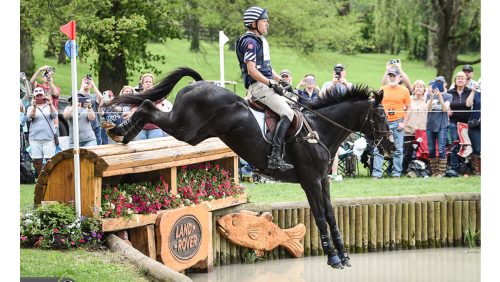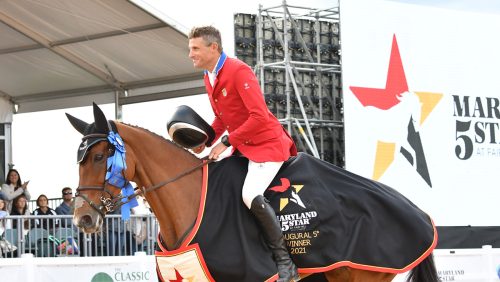From South America to Europe to Hong Kong, if there’s a major international three-day event taking place, Shannon Brinkman is bound to be there, shooting her signature images. Brinkman, 55, grew up riding in Jacksonville, Florida, and she fell in love with photography when she received her first camera at age 11. She studied art and photography at the University of North Florida before founding Shannon Brinkman Photography in 1991.
Brinkman, of Bywater, New Orleans, is the official photographer for many of the biggest events in the United States, and she took us through a day in her life this fall at the MARS Tryon International Three-Day Event in Mill Spring, North Carolina, as she prepared for cross-country and tackled seven hours of dressage with her team photographers.
6. a.m. None of us slept very well last night because the rain was pouring down so hard. We wake up early to study the cross-country course before dressage starts. Two of my team members [go] to the back of the cabin, return, and tell me the creek is three times the size of its normal width. I say, “All right, we’re probably not going to be able to walk the cross-country today; let’s just go see what it looks like.”

While in California to shoot the 2019 Longines FEI World Cup Thermal qualifier, Shannon Brinkman made time to go hiking at Joshua Tree National Park. Photo Courtest of Shannon Brinkman
I do not eat breakfast this morning. I normally eat some yogurt and cereal or an egg, but because we did not sleep, I just have a cup of coffee and some orange juice.
I have a crew of three with me, and then I have a couple more people helping with remote [cameras] on the weekend. We got a cabin, so we have a great space to work out of, and we don’t have to leave the showgrounds; this is a luxury.
8 a.m. We get in a car and drive to the top of the hill and start walking down. When we get around the bend to where you can see the valley, the creek is running over rapidly—water is spilling out and flooding in some lower set areas. I run into [course designer Capt. Mark Phillips], and he tells me that if it stops raining, the course will drain well, and they will be able to run, but they will need an extra day to let it drain.
I like walking the cross-country multiple times. I especially enjoy walking the cross-country with my photographer friend, Alison Green, as she gets just as excited about cross-country as I do. We sometimes have very different ways of looking at the course, which is enjoyable and helpful for each of us.
When I look at a cross-country course, I try to look at the course from all different angles because I believe you can, of course, photograph a course from all different angles. So, my goal is to do a gallery that has some remote shots that have some skies, some blue. Essentially, some low shots, many long shots, and at least a couple side shots because riders like to see all the angles. I generally don’t edit out a lot of photographs unless it’s blurry or something, and even then, a lot of times, we’re so busy that we don’t even edit out all of that.
It’s nice if the photographer does edit some in-camera, but I don’t require that. The riders like to see the approach to the fence, the way the horse uses its body and where it takes off from a fence, and how it tucks its back legs underneath and where it pushes off. Sometimes, I’ll have all of that in there, but basically, I want pictures from the front, from the side, from low, and some drama where we can see the horse and the rider’s face. Hopefully, something with the landscape; it just depends on the course. So, if I find a pretty, scenic background, I’ll try to get that in there if it’s a clean shot.
ADVERTISEMENT

Shannon Brinkman (center left) and team like to walk the cross country course prior to the start of an event. Photo Courtesy of Alison Green
[The number of pictures I take] entirely depends on what is going on. Sometimes I shoot less at, say, a four-star or a five-star-cross-country day than I would at a lower level because there are more riders at the lower level. So, probably at least 2,000-4,000 images. That’s just mine personally, and generally that’s because I’m frequently using three cameras. I might have a remote or two set up, plus I’m shooting with two other cameras with different length lenses.
9 a.m. We come back [to the cabin] because we couldn’t look at the cross-country course. Luckily, I looked at it yesterday. We pack our gear for the day. For dressage, I always bring extra camera bodies, lenses, computers, hard drives, card readers, rain gear for all the cameras, monopods—I’m like a walking camera store.
9:40 a.m. Start the [dressage] test rides. There are three rings and three of us photographing. My fourth person is walking around, doing candids.
[When taking dressage photos], I’m looking at the way a horse moves. Some horses at the trot—I might have to wait a moment if they have a high reach in the front, so I don’t get the hind leg out behind them. I’m looking at the expression. If the horse has its mouth open, I might not take the shot. At the canter, I generally watch the hind leg but not always. Sometimes, I’m just looking at the whole movement of the horse. It’s a lot about the expression. If the horse is pulling against the rider, I might wait a moment and not take that shot.
I like all the phases. [For show jumping], I love walking the course because I like to see where the rider will be looking, so I try to position myself at one or two places where I can capture the rider looking at me. Again, it’s kind of like cross-country—something from the side, something from the front, all of the drama. I look at the background. If it’s [somewhere] like Rebecca Farms [in Montana], maybe I can get a mountain in the back, something that gives you a sense of place.
We were always taught to photograph the knees up [on cross-country]. In the jumpers, to have the knees and the back feet on the same level when the horse is at the top of the fence. That’s because the fences are so big. If it’s a lower-level horse, they’re not going to jump like that unless it’s a one-off.
When digital cameras came into the amateurs’ hands, it seems like the idea of what the best moment was changed because a lot of people photograph with the front foot after the pole or the top of the fence, when the horse is coming down. I was taught that that is just not the moment. But a lot of people order those now, so I sometimes offer them too.
Sometimes though, it is nice when they’re coming down because maybe the rider’s face is hidden behind the horse going up, or you can’t see the rider’s face as well until they’re coming down because maybe they’re looking down. Everybody’s idea of photos is different. I’m always interested in seeing what people order. Sometimes, if I see that they ordered a photo that I don’t really like, I might, if I have a moment, say, “Hey, I see you ordered this picture, but maybe this photo is slightly better,” and I’ll tell them why.

In one of her favorite photographs taken at the MARS Tryon International Three-Day Event, Shannon Brinkman captured Woods Baughman and C’est La Vie 135 clearing a cross-country fence with the lake in the background. Shannon Brinkman Photography Photo
1:30-2:30 p.m. The break is later today. I have a peanut butter and honey sandwich and an apple. I eat way too much chocolate because MARS is the sponsor here and supplied their sweets.
ADVERTISEMENT
They have the media center open, and because of COVID, I sit by the table by the front door and leave it open. That’s where I work by myself all day long. Whenever I am not photographing, I am sitting there uploading, sorting images for media. I really don’t take a break.
This weekend, because it’s a championship, [Tryon] requires the official photographer to send five photos a day. I take photos for the U.S. Equestrian Federation, Eventing Nation, press for Tryon, and photos for a couple of riders who need photos because of COVID—their photographers aren’t here. So, I send some photos out to those riders. I do social media posts when I have a moment, which is never a moment because it’s always busy.
4:30 p.m. My ring finishes. I sit in the media center, finishing up the galleries, waiting for my photographers to send me their best of the three-star and two-star so I can send that to Tryon. Then, I edit everyone’s photos so everything matches, and it looks like one mind did it, even if it was three different photographers. I edit the images to bring out the color, so nothing is straight out of the camera.
I know some photo outlets have editors to file photos, but I think the best way to teach people is to have them edit their own or other people’s photographs. So, everybody that helps me is currently filing photos, either their own or somebody else’s. And it helps with learning, seeing, “Oh, look at how this person photographs.” When we have an outstanding image we are proud of, we can share and be excited and inspired.
Each time we import a card, we [file with] the show initials at the beginning, the year, my last name, the date, what discipline it is with a “d” or an “s” or an “x” or “hi” for horse inspection, and the photographer’s initials. We have many hard drives with one hard drive where all the images are sorted into galleries. Sometimes we don’t finish, and then I take the work home and file it at home. It just depends on the day. Tomorrow we have the luxury of only having a couple hours of dressage in two rings. My ring will go all day, so we will have all the dressage filed by tomorrow because there’s not as much to do as we normally do that day.

After a day of shooting at the Tryon International Equestrian Center, Tanner Messer (bottom left), Alison Green (top left) and Shannon Brinkman ate dinner while editing and filing pictures taken earlier in the day. Alleyn Evans Photo
7 p.m. I love to feed my crew really good food because we work so hard. I’m a little crazy—I buy all organic groceries, and somebody is always present that can cook. I really appreciate having wholesome food that’s not from a can at the end of the day of working so hard. [One of my photographers] Alleyn Evans cooks, and she makes potatoes with meat and greens. The greens are from turnips she grew in her garden. The meal is delicious.
My whole goal is to make the team work together and have a happy team, people who really want to go do this because it’s long hours, and you’re dirty and tired. It’s not like only shooting dressage or show jumping because you have to do all three phases, and you have to be out in the weather.
10 p.m. I try to go to bed.














